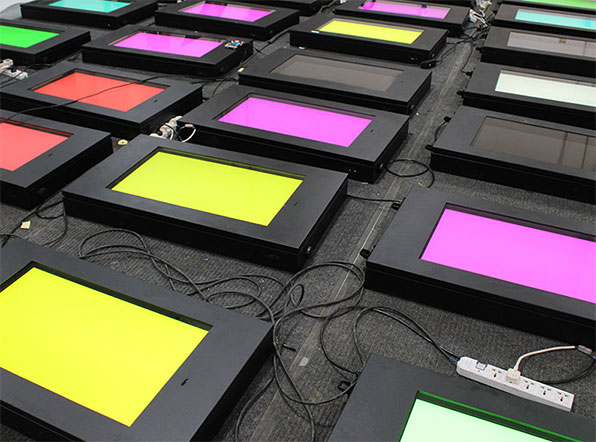Written By Mark Wang On 19th November 2022
In the commercial display industry, when it comes to resolution, the first display we understand and buy is generally 2K 1920*1080, followed by 4K 3840*2160, and for the size of the size, general display suppliers will directly provide the corresponding size of the resolution screen (this is the case in the absence of special requirements): for example, 32 inches to 55 inches, the general machine Resolution is 2K, 65 inches to 120 inches, the general display supplier will provide 4K to ensure that the large size display out of the image is clear enough. Compared to 8K, few customers use.
In fact, from a practical and practical point of view, the most adaptable is the most cost-effective method. If you choose the machine screen is not large, there is no need to use 4k resolution. If the maximum front-end signal acquisition is only 2 million, you have to use a 4K commercial display, you think it is really necessary? CY Digital Signage tell you factually, it is not necessary!

Next, let's understand what 'P', 'K' and 'MP' mean respectively?
What is P?
720P, 1080P, etc., said the "total number of lines of video pixels", for example, 720P said the video has 720 lines of pixels, while 1080P said the video has a total of 1080 lines of pixels, 1080P resolution camera is usually the number of pixels is 1920 * 1080. "P" itself means "Progressive", which is an abbreviation for Progressive, as opposed to Interlaced.
What is K?
2K, 4K, etc., said the "total number of video pixels", such as 4K, said the video has 4000 columns of pixels, specifically 3840 or 4096 columns. 4K resolution cameras are usually 3840 * 2160 or 4096 * 2160 pixels.

What is MP?
MP is the total number of pixels, which is the result of multiplying the number of rows (P) and columns (K) of pixels (megapixels). For example, a 1080P camera is 1920 pixels multiplied by 1080 pixels to get a total number of pixels of 2MP (megapixels).
What is 1080P (or Full HD) ?
Vertical resolution has been used in the past to describe resolution. Therefore 1080p represents vertical resolution. Almost all HD displays have an aspect ratio of 1.78:1 (i.e. 16×9, aka "widescreen"), which means that their horizontal resolution is 1920 pixels (i.e. 1920×1080).
This is another reason for the current confusion about the concept of resolution, after all, in the past decades we are talking about the vertical resolution when discussing the resolution of the TV, now suddenly become the horizontal resolution of "4K", we will be confused. Therefore, 1080p is not the same as "1K". Just as Ultra HD is equivalent to 4K, 1080p is equivalent to 2K, which means that the resolution of 1920×1080 is very close to the 2K standard described by DCI. Even so, most people tend not to call 1080p 2K, they call it 1080p or Full HD. And 720p has about half the number of pixels of 1080p.

What is 4K resolution?
Let's start by exploring 4K, the top resolution in the current market, so we can talk about the basic principles to describe when answering most resolution doubts. Technically speaking, "4K" means a horizontal resolution of 4096 pixels. This is the resolution proposed by the Digital Cinema Initiatives. The vertical resolution is not specified because the exact shape of the rectangular screen determines the aspect ratio of the film, which is different.
So technically speaking, "4K" is not Ultra HD, which is a resolution of 3840 x 2160, and the difference in pixels between the two is only 13%, so you basically don't see much difference. The vast majority of people prefer the name "4K" for Ultra HD.
What is 8K resolution?
The reasoning behind 8K is the same as 4K. If you're talking about the display, it has twice as many horizontal and vertical pixels as a 4K display: 7680 x 4320. But there are not many 8K video sources, and we're still far from 8K becoming mainstream, so we won't talk about it separately. In order to better support naked eye 3D display technology, Super Hi-Vision frame rate is uniformly increased to 120fps; the standard viewing distance and viewing angle mode are also greatly improved.
Of course, we almost never saw the term "2K" before "4K" became commonplace. It often referred to the "standard format". Most digital cinema projectors used in theaters have a resolution of 2K (some have lower resolutions). Again, according to the DCI, it only specifies a horizontal resolution of 2048, not a vertical resolution.

Conclusion
Basically, the most commonly used resolutions for our commercial display advertisers are 2K and 4K. 2K resolution commercial displays is cheaper than 4K, but the image of 4K commercial display is sharper than the image of 2K commercial display. The rest will be used specifically based on the usage scenario.
 Mark Wang
Mark Wang
Mark Wang is the Chief Technology Officer at CY Digital Signage. And he has over 15 years experiences in digital signage solutions.
